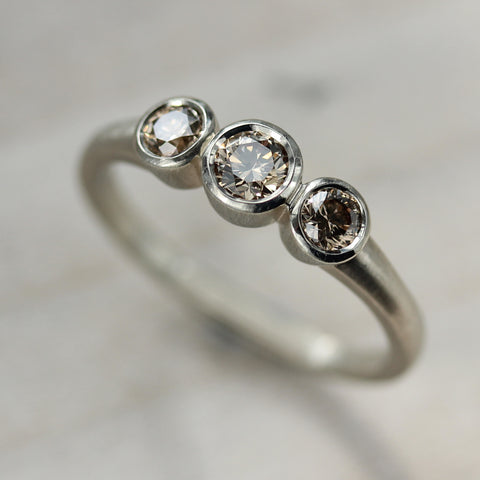4 Ways to Choose an Ethical Diamond
You know that you want an ethically and environmentally conscious diamond. That’s great! But if you are like many people out there, knowing precisely what that means is an entirely different story. What exactly is an ethical diamond? How is a diamond gemstone related to environmental risk? Here is a guide designed to explain the separate characteristics and benefits of the four types of diamonds that we offer. We’ve very carefully chosen these diamonds to work with because they have minimal environmental impact and high labor standards – we only select sources where workers are treated well and paid fairly.
 Octagon Ring with Recycled Diamonds
Octagon Ring with Recycled Diamonds
Recycled Diamonds
A “recycled” or second-hand diamond is our standard diamond option. It is one that has already been previously mined. These classic beauties are meticulously graded, re-polished and buffed to their original sheen and luster to be placed in new settings. A recycled diamond is, on average, significantly less expensive than a new one. By choosing a recycled diamond, you are not contributing to the more than 150 million carats of new diamonds that are mined from the earth each year. Unlike lab-grown diamonds, second-hand diamonds also have greater availability. But, perhaps one of the best features of recycled diamonds is the allure of time; these gemstones have the aura of having seen different decades and periods in history. It is rare, but some recycled gemstones are so old that they were cut by hand directly at a mine more than a hundred years ago!
 Classic Band with Lab-grown Flush-set Diamond
Classic Band with Lab-grown Flush-set Diamond
Lab-grown or Synthetic Diamonds
Lab-grown diamonds have several great features that make them another ideal choice for socially and environmentally conscious brides and grooms to be. They are typically twenty to thirty percent less expensive than newly mined diamonds, have extensive options for customization in size, cut, clarity, and color, while still maintaining the exact same chemical composition of a natural diamond. New diamonds from heavily sourced, conflict-zone locations further pollute the surrounding environment and often place mineworkers in danger for shockingly low wages. In contrast, the lab-grown diamonds we work with are created in the Netherlands. No water or air pollution result from their production and only a modest amount of energy is consumed. For this process, they primarily use renewable resources.
 Three Stone Ring with Australian Champagne Diamonds
Three Stone Ring with Australian Champagne Diamonds
If a newly-mined natural diamond is your choice, then choosing a mine that ethically sources diamonds is key. We only work with two diamond dealers for newly-mined diamonds who have proven that they adhere to the highest labor and environmental standards with mine to market traceability. They go far beyond the requirements of the Kimberly Process, which aims to prevent any “conflict” diamonds from entering the marketplace, but relying on the Kimberly Process alone is not enough to insure that a diamond is conflict-free.
Newly-Mined Canadian Diamonds
Newly-mined diamonds from the Canadian Arctic must adhere to strict standards outlined by the Canadian Code of Conduct and other government authorities. They are all certified as conflict-free and must be cut and polished responsibly. Employees in the industry are paid fair wages, and efforts are made to reduce negative environmental impact as much as possible.
Newly-Mined Australian Diamonds
Similar to Canadian-mined diamonds, newly-mined Australian diamonds are also subject to closely monitored standards that value socially ethical and environmentally responsible practices. One of the more unique aspects of Australian-mined diamonds is the array of natural colors available. They range from translucent yellows, soft chocolate browns, and other earth-tone varieties.
 Square Solitaire Engagement Ring with Recycled Diamond
Square Solitaire Engagement Ring with Recycled Diamond
Availability
In our efforts to provide the very best ethically and environmentally conscious diamond options to our customers, we adhere to the strictest standards of traceability that sometimes limit the availability of certain gemstone cuts. Raw diamonds and black diamonds are typically hard to secure as they very often can be traced back to conflict-zones. However, we are more than happy to work with you in your search for the perfect diamond regardless of your varied needs.
 3mm Classic Engagement Ring with Recycled Diamond
3mm Classic Engagement Ring with Recycled Diamond
Grading
Diamonds larger than .23 carats, which is approximately 4mm in diameter, typically come with a certificate outlining the stone’s grading for cut, color, clarity, carat weight, and origin. Diamonds smaller than this carat weight are considered “melee” and are traditionally loosely graded and will not be paired with an accompanying certificate.
If you would like a diamond other than our standard recycled diamond option, or have any questions regarding specific aspects concerning carat weight and other factors, please feel free to contact us! We will work one-on-one with you to determine your best available options. We can either work with information you supply us, or we can do all the hard “sleuthing” and come up with an ethically and socially responsible diamond we know you will love forever.
